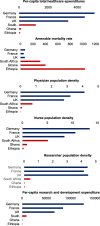Implementation science in resource-poor countries and communities
- PMID: 30587195
- PMCID: PMC6307212
- DOI: 10.1186/s13012-018-0847-1
Implementation science in resource-poor countries and communities
Abstract
Background: Implementation science in resource-poor countries and communities is arguably more important than implementation science in resource-rich settings, because resource poverty requires novel solutions to ensure that research results are translated into routine practice and benefit the largest possible number of people.
Methods: We reviewed the role of resources in the extant implementation science frameworks and literature. We analyzed opportunities for implementation science in resource-poor countries and communities, as well as threats to the realization of these opportunities.
Results: Many of the frameworks that provide theoretical guidance for implementation science view resources as contextual factors that are important to (i) predict the feasibility of implementation of research results in routine practice, (ii) explain implementation success and failure, (iii) adapt novel evidence-based practices to local constraints, and (iv) design the implementation process to account for local constraints. Implementation science for resource-poor settings shifts this view from "resources as context" to "resources as primary research object." We find a growing body of implementation research aiming to discover and test novel approaches to generate resources for the delivery of evidence-based practice in routine care, including approaches to create higher-skilled health workers-through tele-education and telemedicine, freeing up higher-skilled health workers-through task-shifting and new technologies and models of care, and increasing laboratory capacity through new technologies and the availability of medicines through supply chain innovations. In contrast, only few studies have investigated approaches to change the behavior and utilization of healthcare resources in resource-poor settings. We identify three specific opportunities for implementation science in resource-poor settings. First, intervention and methods innovations thrive under constraints. Second, reverse innovation transferring novel approaches from resource-poor to research-rich settings will gain in importance. Third, policy makers in resource-poor countries tend to be open for close collaboration with scientists in implementation research projects aimed at informing national and local policy.
Conclusions: Implementation science in resource-poor countries and communities offers important opportunities for future discoveries and reverse innovation. To harness this potential, funders need to strongly support research projects in resource-poor settings, as well as the training of the next generation of implementation scientists working on new ways to create healthcare resources where they lack most and to ensure that those resources are utilized to deliver care that is based on the latest research results.
Keywords: Capacity; Capacity building; Implementation; Research methods; Resource-poor settings; Resources; Reverse innovation.
Conflict of interest statement
Authors’ information
Till Bärnighausen is the Alexander von Humboldt University Professor and Director of the Heidelberg Institute of Global Health (HIGH) at the University of Heidelberg, Heidelberg, Germany.
H. Manisha Yapa is a medical specialist in Infectious Diseases and a PhD candidate at the Kirby Institute, University of New South Wales, Sydney Australia.
Ethics approval and consent to participate
Not applicable
Consent for publication
Not applicable
Competing interests
The authors declare that they have no competing interests.
Publisher’s Note
Springer Nature remains neutral with regard to jurisdictional claims in published maps and institutional affiliations.
Figures
Similar articles
-
The Role of Implementation Science in Advancing Resource Generation for Health Interventions in Low- and Middle-Income Countries.Health Serv Insights. 2021 Mar 15;14:1178632921999652. doi: 10.1177/1178632921999652. eCollection 2021. Health Serv Insights. 2021. PMID: 33795935 Free PMC article.
-
Criteria to assess potential reverse innovations: opportunities for shared learning between high- and low-income countries.Global Health. 2017 Jan 25;13(1):4. doi: 10.1186/s12992-016-0225-1. Global Health. 2017. PMID: 28122623 Free PMC article.
-
Critical care in resource-poor settings: lessons learned and future directions.Crit Care Med. 2011 Apr;39(4):860-7. doi: 10.1097/CCM.0b013e318206d6d5. Crit Care Med. 2011. PMID: 21297458
-
Global Critical Care: Moving Forward in Resource-Limited Settings.Ann Glob Health. 2019 Jan 22;85(1):3. doi: 10.5334/aogh.2413. Ann Glob Health. 2019. PMID: 30741504 Free PMC article. Review.
-
Sustainability in Health care by Allocating Resources Effectively (SHARE) 2: identifying opportunities for disinvestment in a local healthcare setting.BMC Health Serv Res. 2017 May 5;17(1):328. doi: 10.1186/s12913-017-2211-6. BMC Health Serv Res. 2017. PMID: 28476159 Free PMC article. Review.
Cited by
-
Uterine Artery Doppler Ultrasonography for First Trimester Prediction of Preeclampsia in Individuals at Risk from Low-Resource Settings.Medicina (Kaunas). 2020 Aug 26;56(9):428. doi: 10.3390/medicina56090428. Medicina (Kaunas). 2020. PMID: 32858825 Free PMC article.
-
Understanding the factors influencing the implementation of participatory interventions to improve care coordination. An analytical framework based on an evaluation in Latin America.Health Policy Plan. 2020 Oct 1;35(8):962-972. doi: 10.1093/heapol/czaa066. Health Policy Plan. 2020. PMID: 32743666 Free PMC article.
-
Contextual equipoise: a novel concept to inform ethical implications for implementation research in low-income and middle-income countries.BMJ Glob Health. 2020 Dec;5(12):e003456. doi: 10.1136/bmjgh-2020-003456. BMJ Glob Health. 2020. PMID: 33355266 Free PMC article. Review.
-
The learning health system imperative in low-resource contexts.Learn Health Syst. 2025 Feb 10;9(3):e70002. doi: 10.1002/lrh2.70002. eCollection 2025 Jul. Learn Health Syst. 2025. PMID: 40677612 Free PMC article.
-
Can care coordination across levels be improved through the implementation of participatory action research interventions? Outcomes and conditions for sustaining changes in five Latin American countries.BMC Health Serv Res. 2020 Oct 12;20(1):941. doi: 10.1186/s12913-020-05781-7. BMC Health Serv Res. 2020. PMID: 33046079 Free PMC article.
References
-
- Nolte E, McKee M. Does healthcare save lives? Avoidable mortality revisited. London: Nuffield Trust; 2004.
-
- GBD 2015 Healthcare Access and Quality Collaborators Healthcare Access and Quality Index based on mortality from causes amenable to personal health care in 195 countries and territories, 1990–2015: a novel analysis from the Global Burden of Disease Study 2015. Lancet. 2017;390(10091):231–266. doi: 10.1016/S0140-6736(17)30818-8. - DOI - PMC - PubMed
-
- World Bank Group . Africa’s pulse, No. 16. Washington, DC: World Bank; 2017.
-
- The Equality Trust . The cost of inequality. London: The Equality Trust; 2014.
Publication types
MeSH terms
Grants and funding
LinkOut - more resources
Full Text Sources
Medical


